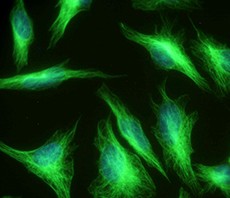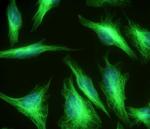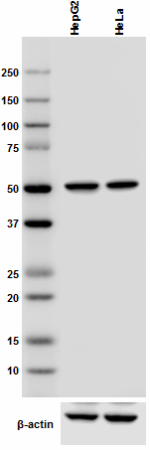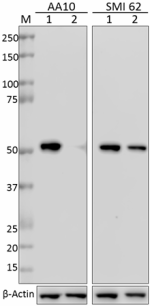- Clone
- SMI 62 (See other available formats)
- Regulatory Status
- RUO
- Other Names
- CDCBM, CDCBM1, CFEOM3, CFEOM3A, FEOM3, TUBB4, Tubulin beta-3 chain, tubulin beta-III, tubulin beta-4 chain, class III beta-tubulin
- Previously
-
Covance Catalog# SMI-62R
- Isotype
- Mouse IgG1
- Ave. Rating
- Submit a Review
- Product Citations
- publications

-

Staining of Polymerized Beta Tubulin (SMI 62) on Hela cells using MeOH fixation. -

Total lysates (15 µg protein) from HepG2 and HeLa cells were resolved by electrophoresis (4-20% Tris-glycine gel), transferred to nitrocellulose, and probed with 1:1000 anti-Tubulin β-3, Polymerized (TUBB3) antibody, clone SMI 62. Proteins were visualized using chemiluminescence detection by incubation with HRP Goat anti-Mouse secondary antibody (Cat. No. 405306, 1:3000 dilution). Direct-Blot™ HRP anti-β-actin antibody was used as a loading control (Cat. No. 643807, 1:8000 dilution). -

Whole cell lysates (15 µg protein) from A549 (lane 1) and HeLa (lane 2) cells were resolved by electrophoresis (4-12% Bis-Tris gel), transferred to nitrocellulose, and probed with 0.1 µg/mL (1:5000 dilution) of purified anti-Tubulin Beta 3 (TUBB3) antibody, clone AA10, or anti-Tubulin β-3, Polymerized (TUBB3) antibody (clone SMI 62) (1:1000 dilution). Proteins were visualized using chemiluminescence detection by incubating with 1:3000 dilution of HRP goat anti-mouse-IgG secondary antibody (Cat. No. 405306). Direct-Blot™ HRP anti-β-Actin antibody (1:5000 dilution, Cat. No. 643807) was used as a loading control (lower). Lane M: MW ladder. Cell lysates were loaded in order of decreasing TUBB3 mRNA expression levels; A549 cells express ~14-fold more TUBB3 mRNA than HeLa cells (source: Human Protein Atlas). Lane M: Molecular Weight marker.
| Cat # | Size | Price | Quantity Check Availability | Save | ||
|---|---|---|---|---|---|---|
| 921001 | 500 µL | 279€ | ||||
Microtubules are required for many well characterized functions in eukaryotic cells, including the movement of chromosomes in mitosis and meiosis, intracellular transport, establishment and maintenance of cellular morphology, cell growth, cell migration, and morphogenesis in multicellular organisms. The building block of a microtubule is the tubulin subunit, a heterodimer of α- and β-tubulin. Both of these monomers are found in all eukaryotes, and their sequences are highly conserved. TUBB3 is primarily expressed in neurons and may be involved in neurogenesis and axon guidance and maintenance.
Product DetailsProduct Details
- Verified Reactivity
- Human
- Reported Reactivity
- Other species
- Antibody Type
- Monoclonal
- Host Species
- Mouse
- Formulation
- Ascites Fluid (contains 0.01M sodium azide).
- Preparation
- Ascites
- Concentration
- The concentration is not quantified as this product is sold as undiluted crude mouse ascites fluid. The concentration might vary from lot-to-lot and an estimated concentration would be 1-3 mg/ml.
- Storage & Handling
- Store at -20°C. Upon initial thawing, apportion into working aliquots and store at -20°C. Avoid repeated freeze-thaw cycles to prevent denaturing the antibody. For long-term storage, keep the antibody at -80°C.
- Application
-
ICC - Quality tested
ELISA, WB
SB - Community verified - Recommended Usage
-
The optimal working dilution should be determined for each specific assay condition. The extent of permissible dilution of SMI 62 beyond those recommended for general application depends upon nature and concentration of the antigen examined, species of the antigen, method of fixation and kind of section examined.
• WB: 1:1,000
• ICC: 1:1,000
• ELISA: 1:1,000 - Application Notes
-
This antibody is effective in immunoblotting (WB), immunocytochemistry (ICC), and ELISA.
SMI 62 reacts with polymerized ß-tubulin. The antibody has a preference for recognizing polymerized tubulin in immunocytochemistry. This antibody helps reduce background in cell staining applications caused by unpolymerized tubulin in the cytoplasm. Reaction is observed with cold-stabilized tubulin, premitotic, interphase and mitotic nuclei and flagellar tubulin. SMI 62 reacts with most mammalian species in neuronal and non-neuronal tissue. Green algae and molds also react with SMI 62.
Observed MW is at 50 kDa.
This clone shows high reactivity towards other ß–tubulin isotypes. - Additional Product Notes
-
This product has been verified for IHC-F (Immunohistochemistry - frozen tissue sections) on the NanoString GeoMx® Digital Spatial Profiler. The GeoMx® enables researchers to perform spatial analysis of protein and RNA targets in FFPE and fresh frozen human and mouse samples. For more information about our spatial biology products and the GeoMx® platform, please visit our spatial biology page.
- Application References
-
- Zhu B, et al. 2010. Am J Physiol Lung Cell Mol Physiol. 299: L493. (WB) PubMed
- Fortune B, et al. 2008. Invest. Ophthalmol. Vis. Sci. 49: 255.
- Product Citations
-
- RRID
-
AB_2565385 (BioLegend Cat. No. 921001)
Antigen Details
- Cell Type
- Mature Neurons
- Biology Area
- Cell Biology, Cell Motility/Cytoskeleton/Structure, Neuroscience, Neuroscience Cell Markers
- Molecular Family
- Microtubules
- Gene ID
- 203068 View all products for this Gene ID
- UniProt
- View information about Tubulin beta-3 on UniProt.org
Related Pages & Pathways
Pages
Related FAQs
- If an antibody clone has been previously successfully used in IBEX in one fluorescent format, will other antibody formats work as well?
-
It’s likely that other fluorophore conjugates to the same antibody clone will also be compatible with IBEX using the same sample fixation procedure. Ultimately a directly conjugated antibody’s utility in fluorescent imaging and IBEX may be specific to the sample and microscope being used in the experiment. Some antibody clone conjugates may perform better than others due to performance differences in non-specific binding, fluorophore brightness, and other biochemical properties unique to that conjugate.
- Will antibodies my lab is already using for fluorescent or chromogenic IHC work in IBEX?
-
Fundamentally, IBEX as a technique that works much in the same way as single antibody panels or single marker IF/IHC. If you’re already successfully using an antibody clone on a sample of interest, it is likely that clone will have utility in IBEX. It is expected some optimization and testing of different antibody fluorophore conjugates will be required to find a suitable format; however, legacy microscopy techniques like chromogenic IHC on fixed or frozen tissue is an excellent place to start looking for useful antibodies.
- Are other fluorophores compatible with IBEX?
-
Over 18 fluorescent formats have been screened for use in IBEX, however, it is likely that other fluorophores are able to be rapidly bleached in IBEX. If a fluorophore format is already suitable for your imaging platform it can be tested for compatibility in IBEX.
- The same antibody works in one tissue type but not another. What is happening?
-
Differences in tissue properties may impact both the ability of an antibody to bind its target specifically and impact the ability of a specific fluorophore conjugate to overcome the background fluorescent signal in a given tissue. Secondary stains, as well as testing multiple fluorescent conjugates of the same clone, may help to troubleshoot challenging targets or tissues. Using a reference control tissue may also give confidence in the specificity of your staining.
- How can I be sure the staining I’m seeing in my tissue is real?
-
In general, best practices for validating an antibody in traditional chromogenic or fluorescent IHC are applicable to IBEX. Please reference the Nature Methods review on antibody based multiplexed imaging for resources on validating antibodies for IBEX.
Other Formats
View All Tubulin β-3, Polymerized Reagents Request Custom Conjugation| Description | Clone | Applications |
|---|---|---|
| Anti-Tubulin β-3, Polymerized (TUBB3) | SMI 62 | ICC,ELISA,WB,SB |
Compare Data Across All Formats
This data display is provided for general comparisons between formats.
Your actual data may vary due to variations in samples, target cells, instruments and their settings, staining conditions, and other factors.
If you need assistance with selecting the best format contact our expert technical support team.
 Login / Register
Login / Register 















Follow Us